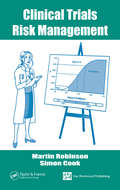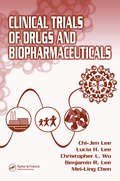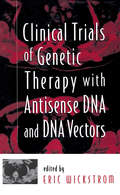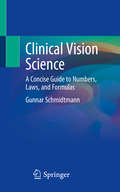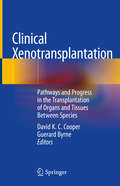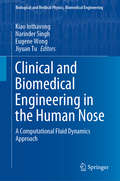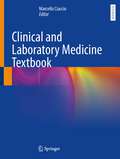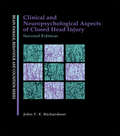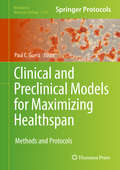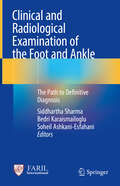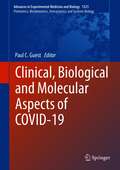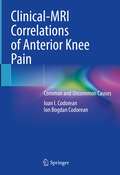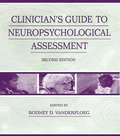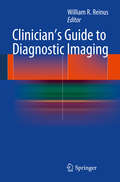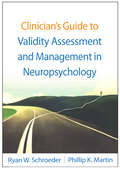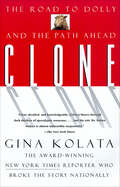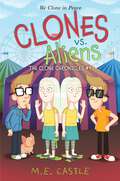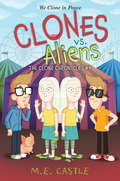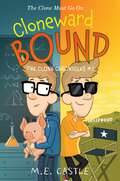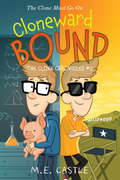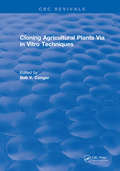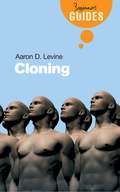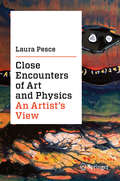- Table View
- List View
Clinical Trials Risk Management
by Martin Robinson Simon CookDrug development is risky business. It is against the backdrop of huge financial, scientific, technical and medical risks that a clinical trials manager is expected to function, effectively identifying and managing all project risks, to deliver a successful outcome. Focusing on the day-to-day needs of a clinical trials manager, Clinical Trials Risk
Clinical Trials of Drugs and Biopharmaceuticals
by Chi-Jen Lee Lucia H. Lee Christopher L. Wu Benjamin R. Lee Mei-Ling ChenThe pharmaceutical industry is on the verge of an exciting and challenging century. Advances in pharmaceutical sciences have dramatically changed the processes of discovery and development of new therapeutic drugs and, in turn, resulted in an extraordinary increase in the potential prophylactic and therapeutic interventions. In this atmosphere, an
Clinical Trials of Genetic Therapy with Antisense DNA and DNA Vectors
by Eric WickstromAn important new collection of clinical and preclinical reports on genetic therapy, this book describes illustrative examples of diseases in which gene-based interventions are presently plausible, and presents case studies of current research using both synthetic oligonucleotides and biological vectors. Combining the insights of over 50 contributors, Clinical Trials of Genetic Therapy with Antisense DNA and DNA Vectorsfurnishes a historical overview of genetic therapy highlights official Food and Drug Administration positions on the preparation of oligonucleotides and vectors offers practical models of agent preparation, animal testing, pharmacokinetics, toxicology, and clinical trials discusses both synthetic DNA and biological vector approaches to cancer, viral, and cardiological indications illustrates for new practitioners how each stage of genetic therapy is developed details genetic treatment of leukemia; lymphoma; cancer of the brain, breast, colon, kidney, and lung; melanoma; HIV; and coronary restenosis includes examples of antisense, ribozyme, tumor suppressor, immunostimulation, and gene replacement therapy and addresses questions of preparation, delivery, toxicity, mechanism, and specificity.
Clinical Vision Science: A Concise Guide to Numbers, Laws, and Formulas
by Gunnar SchmidtmannThis book provides a concise and user-friendly guide to the most common and important numbers, laws and formulas in clinical vision science. Clinicians and trainees in ophthalmology, optometry, orthoptics, and ophthalmic dispensing, who are seeking an easy-to-use lab coat pocket size resource, will find this book to be an essential reference in clinical practice. Clinical Vision Science: A Concise Guide to Numbers, Laws, and Formulas is clearly structured into basics, physical optics, visual optics and ophthalmic lenses, optical instruments, photometry, visual perception, clinical procedures, and anatomy & binocular vision. Each chapter contains a range of tables, formulas, large illustrations and flow charts to allow readers to quickly and accurately find key facts for each type of examination procedure.
Clinical Xenotransplantation: Pathways and Progress in the Transplantation of Organs and Tissues Between Species
by David K. C. Cooper Guerard ByrneThis title provides an illuminating examination of the current state of xenotransplantation – grafting or transplanting organs or tissues between members of different species – and how it might move forward into the clinic. To be sure, this is a critical topic, as a major problem that remains worldwide is an inadequate supply of organs from deceased human donors, severely limiting the number of organ transplants that can be performed each year. Based on presentations given at a major conference on xenotransplantation, this title includes important views from many leading experts who were invited to present their data and opinions on how xenotransplantation can advance into the clinic. Attention was concentrated on pig kidney and heart transplantation as it is in regard to these organs that most progress has been made. Collectively, these chapters effectively highlight the many advantages of xenotransplantation to patients with end-stage organ failure, thereby encouraging the mapping of a concrete pathway to clinical xenotransplantation. The book is organized across 22 chapters, beginning with background information on clinical and experimental xenotransplantation. Following this are discussions addressing how pigs can be genetically engineered for their organs to be resistant to the human immune response through deletion of pig xenoantigens, and the insertion of ‘protective’ human transgenes. Subsequent chapters analyze complications that arise in practice, comparing allotransplant and xenotransplant rejection. The selection of the ideal patients for the first clinical trials is discussed. Finally, the book concludes with an analysis on the regulatory, economic, and social aspects of this research, including FDA perspectives and the sensitive, psychosocial factors regarding allotransplantation and xenotransplantation. A major and timely addition to the literature, Clinical Xenotransplantation will be of great interest to all researchers, physicians, and academics from other disciplines with an interest in xenotransplantation.
Clinical and Biomedical Engineering in the Human Nose: A Computational Fluid Dynamics Approach (Biological and Medical Physics, Biomedical Engineering)
by Jiyuan Tu Kiao Inthavong Narinder Singh Eugene WongThis book explores computational fluid dynamics in the context of the human nose, allowing readers to gain a better understanding of its anatomy and physiology and integrates recent advances in clinical rhinology, otolaryngology and respiratory physiology research. It focuses on advanced research topics, such as virtual surgery, AI-assisted clinical applications and therapy, as well as the latest computational modeling techniques, controversies, challenges and future directions in simulation using CFD software. Presenting perspectives and insights from computational experts and clinical specialists (ENT) combined with technical details of the computational modeling techniques from engineers, this unique reference book will give direction to and inspire future research in this emerging field.
Clinical and Laboratory Medicine Textbook
by Marcello CiaccioThis textbook describes several diseases and clinical conditions, from physiopathological mechanisms to main clinical pictures, highlighting the importance of laboratory medicine, with the aim to provide the necessary tools for guiding correct laboratory findings interpretation. Indeed, it is now widely recognized that laboratory medicine has a pivotal role in clinical medicine, significantly influencing clinical decisions. Thus, it is crucial to understand and use laboratory data appropriately. This book has the great advantage of describing each topic exhaustively in order to facilitate its understanding. Specifically, it describes both diseases with a high incidence in the population, such as Diabetes Mellitus, Cardiovascular Diseases, Dyslipidemias, and Autoimmune Diseases, as well as rare diseases, such as Hereditary Metabolic Diseases. In addition, unusual topics are treated, such as Clinical Biochemistry of the Mind, as well as hot topics, such as Biological Drugs, Biobanks, Health Technology Assessment, and Omics Sciences. Finally, the book includes a chapter on the new health emergency, the SARS-CoV-2 pandemic. Two appendices are provided at the end of the book: a table summarizing the reference range and decisional cut-off for the main laboratory parameters and instructions on performing a venous blood sample. The book will be an invaluable tool for medical and biomedical students, as well as for practitioners.
Clinical and Neuropsychological Aspects of Closed Head Injury (Brain, Behaviour and Cognition)
by Dr J RichardsonIn all industrialised countries, closed head injuries are responsible for vast numbers of hospital admissions and days of work lost. For instance, about 120,000 patients are admitted to hospital in the United Kingdom each year with a diagnosis that reflects closed head injury. Such injuries are a major cause of deaths following accidents, especially those that involve children and young people, and they are also a major cause of handicap and morbidity among the survivors. This clinical condition is intrinsically a neurological one, but its proper evaluation demands an understanding of the associated psychology and psychopathology. At the same time, a major neurological condition with such a high level of incidence ought to be extremely informative about the functioning of the human brain and hence provide a major focus for neuropsychological investigation. In this book, the author seeks to integrate these two different perspectives by reviewing the clinical and neuropsychological aspects of closed head injury in a manner that is equally intelligible to researchers interested in the effects of brain damage upon human behaviour and to practitioners who are responsible for the assessment, management and rehabilitation of head-injured patients.This is the second edition of a book which was first published in 1990, and which has been extensively revised in the light of the subsequent research in the field. The book begins by considering the epidemiology, causes and structural neuropathology of closed head injury. It then considers the impact of closed head injury on memory, cognition, language, communication, personality and social behaviour. Finally it outlines the outcome, the mechanisms of recovery and the prospects for rehabilitation.
Clinical and Preclinical Models for Maximizing Healthspan: Methods and Protocols (Methods in Molecular Biology #2138)
by Paul C. GuestThis book presents a series of protocols in multiple disease areas affected by the aging process along with several methods which have shown progress in nutrient- or intervention-based approaches to maximize the healthspan. Of interest to researchers in the areas of chronic disease, gerontology, physical exercise, and nutrition as well as to clinical scientists, physicians, and pharmacologists, this volume also provides important information on disease mechanisms and novel drug targets as each protocol will be presented in the context of specific chronic diseases or different therapeutic areas. Written for the highly successful Methods in Molecular Biology series format, chapters include introductions to their respective topics, lists of the necessary materials and reagents, step-by-step, readily reproducible laboratory protocols, and tips on troubleshooting and avoiding known pitfalls. Authoritative and practical, Clinical and Preclinical Models for Maximizing Healthspan: Methods and Protocols is an ideal guide for preclinical and clinical researchers working toward the discoveries needed to lead to a world society in which individuals are not only living longer lives but more productive and healthier ones.
Clinical and Radiological Examination of the Foot and Ankle: The Path to Definitive Diagnosis
by Siddhartha Sharma Bedri Karaismailoglu Soheil Ashkani-EsfahaniThe foot and ankle are among the most complicated anatomical regions of the human body, making their examination challenging. The perfect equilibrium between bones, tendons, ligaments, and other anatomical structures can be disturbed by pathological processes leading to complex disorders. The path to definitive diagnosis passes through a comprehensive clinical and radiological examination. However, the sources focusing on examining the foot and ankle pathologies are limited. Hence, this book aims to cover all aspects of clinical and radiological examination of the foot and ankle, including basics, general approach, and a closer look at the different foot and ankle pathologies. It will include the most up-to-date diagnostic methods, special tests, and radiological evaluations and give clues about the various situations that should be considered before going into surgery. With a broad range of clinical and radiological images, the path to diagnosis gets simpler! Chapters provide a systematic approach to evaluating various foot and ankle problems such as instabilities, tendinopathies, deformities, trauma, neuropathies, cartilage disorders, impingement, heel pain, etc. Moreover, it includes a chapter emphasizing the emerging technologies used for more precise clinical evaluation.This book will aid foot & ankle surgeons, podiatrists, and general orthopedic surgeons in understanding clinical and radiological examination for improved diagnosis, as well as fellows, residents, and medical students interested in foot and ankle pathologies.
Clinical, Biological and Molecular Aspects of COVID-19 (Advances in Experimental Medicine and Biology #1321)
by Paul C. GuestThe novel coronavirus 2019 (COVID-19) has caused a serious global pandemic in just eight months. Nearly every country and territory in the world has been affected by the virus. The virulence and infection rate of the virus are profound, and has required extreme social distancing measures across the globe in order to prevent overwhelming the healthcare services and hospitals. COVID-19 appears to have the greatest effects on elderly individuals and those who have co-morbid diseases, such as heart disease, asthma, and diabetes. As the peak begins to slow in many countries, the death rates remain high amidst justified fears of a second wave. A rapid worldwide mobilization has begun to identify effective treatments and develop vaccines.This new volume will increase readers’ understanding of the ongoing COVID-19 pandemic through a series of chapters that address these concerns. Leading experts will discuss the effects of the virus in cases of co-morbidities, new treatment approaches, mental health aspects of the pandemic, and convey the results of survey studies. The book will be an excellent resource for researchers studying virology, metabolic diseases, respiratory disorders, and clinical scientists, physicians, drug companies, and healthcare services and workers.
Clinical-MRI Correlations of Anterior Knee Pain: Common and Uncommon Causes
by Ioan I. Codorean Ion Bogdan CodoreanThe book addresses comprehensively the normal and pathological MRI appearance of the structures of the anterior compartment of the knee, potential sources of pain, in a systematic way, on anatomical layers, from superficial to deep, respectively, from prepatellar soft tissues to intra-articular structures (the synovial lining, patellar and trochlear cartilage). Anterior knee pain can affect any age group and causes a non-specific clinical picture, making it difficult to establish a precise diagnosis and proper management. MRI is currently the standard gold investigation and findings of common an uncommon causes of anterior knee pain are presented.Written by a radiologist and an orthopaedic surgeon with longstanding experience in MRI of musculoskeletal pathology and in sports traumatology, respectively, the book also presents a unique selection of 80 clinical cases of common and less common pathological conditions of anterior knee pain and subdivided in four groups, according to age, from children and adolescents to older adults.Radiologists and orthopaedic surgeons, as well as sport medicine specialists and physiatrists, will find in this book an invaluable tool for their clinical practice.
Clinician's Guide To Neuropsychological Assessment
by Rodney D. VanderploegNeuropsychological assessment is a difficult and complicated process. Often, experienced clinicians as well as trainees and students gloss over fundamental problems or fail to consider potential sources of error. Since formal test data on the surface appear unambiguous and objective, they may fall into the habit of overemphasizing tests and their scores and underemphasizing all the factors that affect the validity, reliability, and interpretability of test data. But interpretation is far from straightforward, and a pragmatic application of assessment results requires attention to a multitude of issues. This long-awaited, updated, and greatly expanded second edition of the Clinician's Guide to Neuropsychological Assessment, like the first, focuses on the clinical practice of neuropsychology. Orienting readers to the entire multitude of issues, it guides them step by step through evaluation and helps them avoid common misconceptions, mistakes, and methodological pitfalls. It is divided into three sections: fundamental elements of the assessment process; special issues, settings, and populations; and new approaches and methodologies. The authors, all of whom are actively engaged in the clinical practice of neuropsychological assessment, as well as in teaching and research, do an outstanding job of integrating the academic and the practical. The Clinician's Guide to Neuropsychological Assessment, Second Edition will be welcomed as a text for graduate courses but also as an invaluable hands-on handbook for interns, postdoctoral fellows, and experienced neuropsychologists alike. No other book offers its combination of breadth across batteries and approaches, depth, and practicality.
Clinician's Guide to Diagnostic Imaging
by William R. ReinusThis book is a concise guide to ordering radiology tests for diagnosis and treatment and provides best practice guidelines for patients whose management depends on a clinical question that is best approached through imaging. Organized primarily by organ system, it outlines considerations in selecting the most efficacious imaging studies based on the clinical history, laboratory values, and physical findings to arrive cost-effectively at a correct diagnosis. It also explores the current limitations of each imaging modality and presents evidence-based information to insure that patient safety considerations are observed when ordering potentially dangerous examinations. Clinician's Guide to Diagnostic Imaging is a valuable resource for all physicians who regularly order imaging studies, including primary care physicians, family practitioners, internists, and surgeons alike. Further, this volume serves as an invaluable reference for medical students who are exposed to medical imaging for their first time or who are rotating through a radiology elective in medical school.
Clinician's Guide to Validity Assessment and Management in Neuropsychology (Evidence-Based Practice in Neuropsychology Series)
by Ryan W. Schroeder Phillip K. MartinThis unique hands-on guide walks neuropsychologists through the process of validity assessment and management in real-world clinical settings. Emphasizing the medical necessity of evaluating validity, the authors provide detailed examples, procedural tips, and downloadable practical tools. Step-by-step guidelines are presented for managing potentially complicated referrals, using the clinical interview to gain awareness of possible concerns, choosing and administering performance and symptom validity tests, and providing feedback and treatment recommendations when invalidity is identified. Clinician–patient relationship issues are sensitively addressed. The book concludes with a chapter-length case example.
Clinicians in Court, Second Edition
by Allan E. BarskyInteracting with the legal system can be stressful and intimidating for mental health professionals. This trusted book provides user-friendly strategies to help clinicians prepare for testimony in court and other legal proceedings. Using vivid case scenarios from family law and other areas, the author explains legal terms and offers practical suggestions for avoiding pitfalls and managing ethical dilemmas. Clear guidelines are presented for record keeping, responding to subpoenas, preparing reports, and performing effectively on the stand as a fact witness or expert witness. Reproducible agreements and other sample documentation can be photocopied from the appendices or downloaded and printed in a convenient 8 1/2" x 11" size. New to This Edition Incorporates updates in research, case law, statutes, and practice. Examines the developing role of mental health professionals as forensic consultants. Increased attention to ethical issues, such as dual relationships, professional boundaries, confidentiality, and competence. An appendix with reflection questions that extend the scope of each chapter. Explores special issues that may arise in cases involving children Supplemental materials for course use-including an instructor's manual-are available at the author's website.
Clockwork Futures: The Science Of Steampunk And The Reinvention Of The Modern World
by Brandy SchillaceAirships and electric submarines, automatons and mesmerists?welcome to the wild world of steampunk. It is all speculative?or is it? Meet the intrepid souls who pushed Victorian technology to its limits and paved the way for our present age. The gear turns, the whistle blows, and the billows expand with electro-mechanical whirring. The shimmering halo of Victorian technology lures us with the stuff of dreams, of nostalgia, of alternate pasts and futures that entice with the suave of James Bond and the savvy of Sherlock Holmes. Fiction, surely. But what if the unusual gadgetry so often depicted as “steampunk” actually made an appearance in history? Zeppelins and steam-trains; arc-lights and magnetic rays: these fascinating (and sometimes doomed) inventions bounded from the tireless minds of unlikely heroes. Such men and women served no secret societies and fought no super-villains, but they did build engines, craft automatons, and engineer a future they hoped would run like clockwork. Along the way, however, these same inventors ushered in a contest between desire and dread. From Newton to Tesla, from candle and clockwork to the age of electricity and manufactured power, technology teetered between the bright dials of fantastic futures and the dark alleyways of industrial catastrophe. In the mesmerizing Clockwork Futures, Brandy Schillace reveals the science behind steampunk, which is every bit as extraordinary as what we might find in the work of Jules Verne, and sometimes, just as fearful. These stories spring from the scientific framework we have inherited. They shed light on how we pursue science, and how we grapple with our destiny—yesterday, today, and tomorrow.
Clone: The Road To Dolly, And The Path Ahead
by Gina KolataThe birth of Dolly -- the world's first clone -- placed in our hands the secret of creation. Few discoveries have so altered our notion of what it means to be human, or presented such a Gordian knot of ethical, spiritual, and scientific questions. Noted science journalist Gina Kolata broke the news nationally in The New York Times and was the first reporter to speak with Dr. Ian Wilmut, the embryologist who cloned Dolly. Now Kolata reveals the story behind Dolly, interweaving the social and cultural tales of our fear and fascination with cloning, reaching back nearly a century, with the riveting scientific accountof how a clone came to be and the mind-boggling questions Dolly presents for our future.Clone is a compelling blend of scientific suspense, dreams dashed, and frauds exposed, with provocative philosophical questions and an astute assessment of why Dolly's birth was only possible now. Like The Making of the Atomic Bomb, Lucy, and Chaos, this book gives us a window on history in the making, and an understanding of its profound effect on our lives.
Clones vs. Aliens (The Clone Chronicles #4)
by M. E. CastleFisher, Two, Amanda, and Veronica are happy to spend their holiday break at Fisher's parents' new amusement park. But when aliens crash-land on Fisher's favorite roller coaster, mistaking it for their home planet, it spells the end of R&R for our heroes. Meet the Gemini: not only are all the aliens identical twins, they're also all beautiful girls. The crew decides the best way to encourage the Gemini girls to vacate the stratosphere is to give them a taste of middle school. But Fisher and his crew learn quickly that the Geminis are not to be messed with, not when they might literally explode at any moment. That's right, the Geminis are like puberty times one million. They can seem sweet as pie, but when they turn on you, they're deadly.
Clones vs. Aliens: The Clone Chronicles #4
by M. E. CastleAliens join in the fun in this fourth book of The Clone Chronicles, a series that "strikes just the right balance between over-the-top adventure and real-life middle school drama," mixing Alex Rider, Diary of a Wimpy Kid, and Michael Buckley's NERD series to create an "action-packed success." Fisher, Two, Amanda, and Veronica are happy to spend their holiday break at Fisher's parents' new amusement park. But when aliens crash-land on Fisher's favorite roller coaster, mistaking it for their home planet, it spells the end of R&R for our heroes. Meet the Gemini: not only are all the aliens identical twins, they're also all beautiful girls. If Fisher and Two already thought girls were hard to understand, wait until they meet alien girls. Now Fisher, Two, Amanda, and Veronica must convince the aliens that Earth is the worst place ever and help them fix their ship. The crew decides the best way to encourage the Gemini girls to vacate the stratosphere is to give them a taste of middle school. And Wompalog Middle School tastes pretty disgusting. But Fisher and his crew learn quickly that the Geminis are not to be messed with, not when they might literally explode at any moment. That's right, the Geminis are like puberty times one million. They can seem sweet as pie, but when they turn on you, they're deadly.
Cloneward Bound (The Clone Chronicles #2)
by M. E. CastleThe second book in the hilarious middle-grade adventure series The Clone Chronicles. Fisher Bas and Two were able to thwart the evil Dr. X, but after somehow surviving the explosion at TechX Enterprises, Two is in Hollywood looking for his "mother." Fisher must bring him back to Palo Alto before his cloning secret is discovered. When a class field trip to see the Dr. Devilish science show arises, it becomes the perfect opportunity for Fisher to find his clone. But all kinds of complications will get in the way—including Amanda Cantrell, who knows more than Fisher would like about Two's identity. As Fisher, FP, and Amanda team up to find Two, they find trouble, hijinx, and the return of an evil mastermind—all set in the glitz of Hollywood.
Cloneward Bound: The Clone Chronicles #2
by M. E. CastleFisher Bas and Two were able to thwart the evil Dr. X, but after somehow surviving the explosion at TechX Enterprises, Two is in Hollywood looking for his "mother." Fisher must bring him back to Palo Alto before his cloning secret is discovered. When a class field trip to see the Dr. Devilish science show arises, it becomes the perfect opportunity for Fisher to find his clone. But all kinds of complications will get in the way--including Amanda Cantrell, who knows more than Fisher would like about Two's identity. As Fisher, FP, and Amanda team up to find Two, they find trouble, high jinx, and the return of an evil mastermind--all set in the glitz of Hollywood.
Cloning Agricultural Plants Via in Vitro Techniques
by Bob V. CongerThe purpose of this book is to provide a reference guide on principles and practices of cloning agricultural plants via in vitro techniques for scientists, students, commercial propagators, and other individuals who are interested in plant cell and tissue culture especially its application for cloning.Plant cell and tissue culture generated much excitement during 1970‘s concerning the potential application of the technology for improving important agricultural crop plants. This originates from the demonstration of cellular totipotency, or the ability to regenerate whole plants from single cells, and the successful creation of hybrids by somatic cell fusion in some species. There are several areas of in vitro culture which have potential practical application. The most practical application is deemed as cloning or mass propagation of selected genotypes. This is evidenced by the large number of commercial firms engaged in propagating a variety of plants through tissue culture.
Cloning: A Beginner's Guide (Beginner's Guides)
by Aaron LevineShould we clone extinct or endangered species? Are we justified in using stem cells to develop cures? When will we clone the first human? Ever since Dolly the sheep, questions like these have rarely been far from the public consciousness, and cloning is now poised to revolutionize medicine, healthcare, and even the food we eat. Aaron Levine offers a masterful and accessible introduction to the science and development of cloning, right up to the present-day scandals surrounding attempts to clone humans. Guiding readers around the thorny political and ethical issues raised by such progress, Levine dispels the myths perpetuated by the media and sheds new light on the pros and cons of this fascinating and controversial topic. Aaron Levine is currently conducting research on the impact of public policy on biomedical research at the Woodrow Wilson School of Public and International Affairs, Princeton University.
Close Encounters of Art and Physics: An Artist's View
by Laura PesceClose Encounters of Art and Physics is a voyage in time through the abstract ideas harboured in the minds of humans, starting from the graffiti art of cave dwellers and extending to the street art of contemporary men and women. In seeking parallels with science, the author looks far back to the first geometric ideas of our ancestors as well as ahead to the contemporary science of present-day physicists. The parallelism and analogies between these two fields bear witness to a real entanglement in the human brain. The second part of the book contains about 25 colour images showing the author's stunning glass artwork representing ideas such as dark matter, quantum entanglement, cellular automata and many others that are almost impossible to capture in words. Furthermore, many of the physicists who have themselves made major contributions in these fields provide their comments and analysis of the works. The book provides entertaining and informative reading, not only for practicing artists and physicists, but also anyone curious about art and physics.
